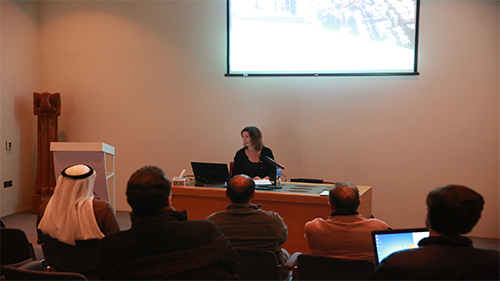21 February 2019
Marking its 11th Anniversary, Qala’at al Bahrain Site Museum, Rediscovers world museums, presenting Louvre Abu Dhabi as an example


Qala’at al-Bahrain Site Museum has marked its 11th Anniversary on 20 February 2019, and for this occasion, a lecture was organized by Bahrain Authority for Culture & Antiquities on “ Louvre Abu Dhabi - Reinventing universal museum?” presented by Noëmi Daucé, who is currently Chief Curator at Louvre Abu Dhabi in charge of Archaeology.
During the lecture, Ms. Noëmi Daucé gave first a detailed explanation of the whole and comprehensive urban development plan of the culture area of Abu Dhabi’s Saadiyat Island. Ms. Daucé argued that Louvre Abu Dhabi is part of a bigger plan to develop and enhance the cultural movement and art scene in the city, which includes also establishing a number of future museums.
Speaking about the museum, Ms. Noëmi Daucé said that born out of an intergovernmental agreement signed in 2007, between the United Arab Emirates and France, the Louvre Abu Dhabi, which is the first universal museum in the Arab world, opened doors to the visitors on 11 November 2017.
Built to house artwork, the building of the Louvre Abu Dhabi has itself become known as a stunning piece of art on the capital’s landscape. It has been designed by Jean Nouvel, who was inspired by the special features of the Saadiyat site: a virgin lagoon island, between sand and sea, shade and light. His design offers visitors a high-impact architectural and museum experience that fosters dialogue between cultures.
With regard to the Louvre Abu Dhabi Museum collections, Ms. Noëmi Daucé said that it is considered” universal”, given the keenness of its management to acquire and collect from all over the world. The permanent collection of the museum covers all the human creative manifestations since times immemorial, prehistory until present, including paintings, sculptures, photography and other artworks. Presented in 12 chronological chapters spanning prehistory to today, the museum’s galleries explore such themes as fertility, power, and the divine.
Ms. Noëmi Daucé added to say that Louvre Abu Dhabi Museum’s loans come from many international cultural institutions by virtue of bilateral agreements; the museum has for example artwork loans from 30 museums in Paris, museums in the UAE, Saudi Arabia, Sultanate of Oman and Jordan.
The museum collection’s four main galleries or halls, feature exhibits from “The First Villages”, the earliest known civilizations, “The First Great Powers” and “Civilizations and Empires”. The second gallery showcases the “Universal Religions”, which one of the most memorable galleries, and is enlightening, exhibiting the main Sacred books and other sacred books, including the Torah, as well as Jain and Buddhist texts. It also include “Asian Trade Routes”, a colorful gallery, shows how cultures and knowledge began to be shared more frequently, with the Islamic civilization at the center of the trade routes. The Third gallery, in an interim section, humanity’s deepening interest in exploration and astronomy is detailed. The World in Perspective gallery shows the European Renaissance, and the developing focus on geometry in the Islamic world. Holding pride of place is Italian master Leonardo da Vinci’s painting, La Belle Ferronniere, on loan from the Louvre Museum in Paris. Further ahead, intricate paintings adorn the Magnificence of the Court gallery, which also features an Ottoman turban helmet and a Chinese armour suit in adjoining cases. The fourth gallery section “, A Modern World?, the visitor can enjoy 19th -20th centuries major artworks ; Vincent Van Gogh’s Self-Portrait is hung next to the famous portrait ‘Whistler’s Mother’ by British painter James McNeill Whistler. Photography is also introduced here, which began to revolutionise artistic creation.
Commenting on the visitors of the Louvre Abu Dhabi, Ms. Noëmi Daucé said that the museum welcomed more than 1 million visitors in its first year, 60% of them come from outside UAE, which manifestly reflects an increasing cultural tourism development in the region and around the world.
Worth to mention that Qal’at al Bahrain Site Museum Site, marking its 11th Anniversary, is the first Bahraini registered UNESCO’s World Heritage List site, represents an iconic symbol of the importance of the archaeological site, and seeks to maintain the ancient historic features of the site, as well as to document the archaeological periods by preserving the artefacts discovered at the site. The site museum overlooks the northern coast of the kingdom of Bahrain, with all its beautiful natural landscape, in complete harmony with the marine environment and the area’s green belt.
Qala’at al-Bahrain Site Museum has succeeded, since its inauguration in 2008, sponsored by Arcapita Bank, to achieve a special partnership with the rest of social categories, raising their awareness about archaeology, history and excavations, through a periodical diverse workshops, lectures, exhibitions and different events. Bahrain Fort site museum also organizes lectures by most prominent experts in archaeological heritage, museums and history from Bahrain and abroad to share their experiences and expertise with the audience eager to learn more about this interesting branch of science and knowledge.







